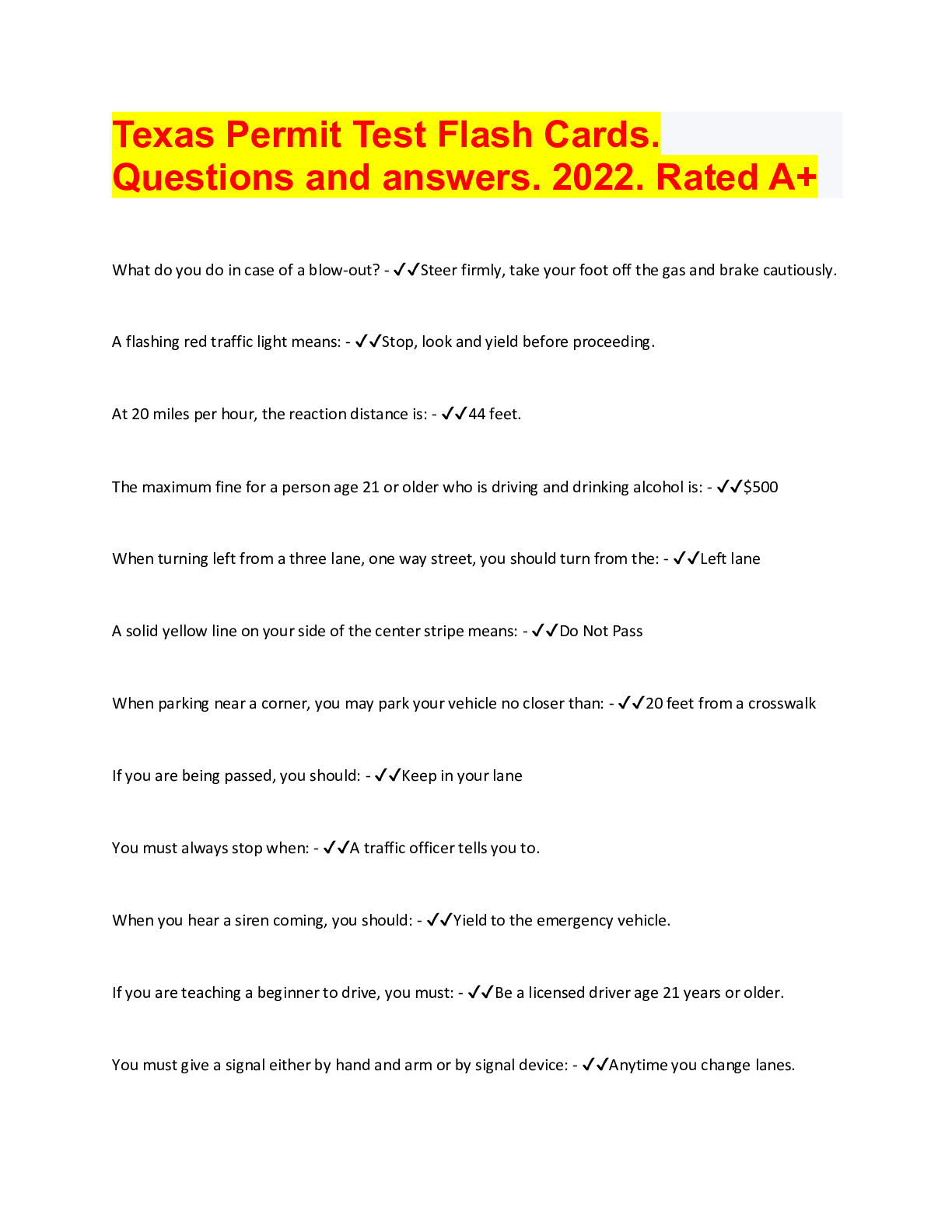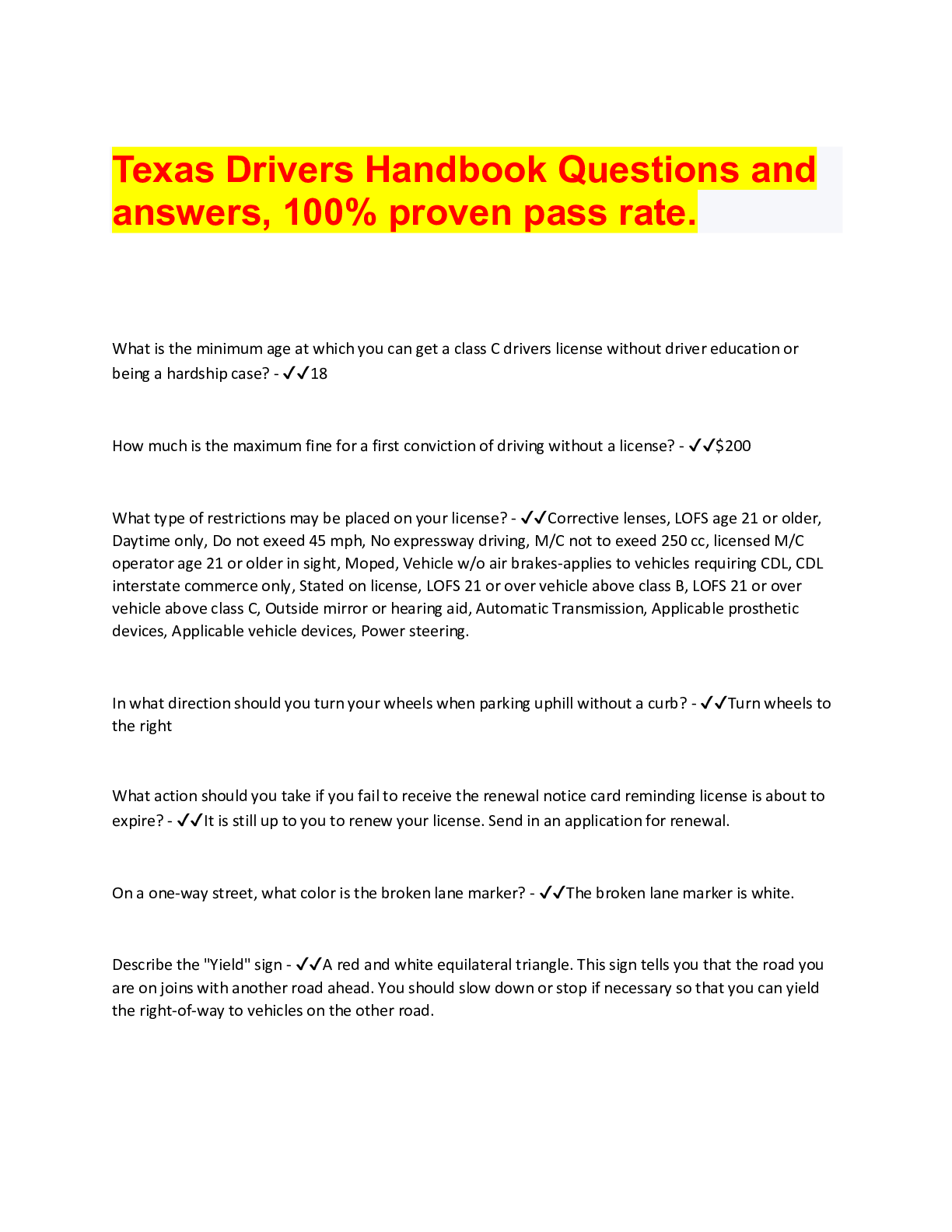
Texas Permit Test Flash Cards. Questions and answers. 2022. Rated A+
$ 8

Texas Drivers Handbook Questions and answers, 100% proven pass rate.
*NURSING > HESI > Maternity HESI 1,2 Test Bank. Questions and Answers. Latest Version with Verified Answers Already Gr (All)
Question 1. A 38-week primigravida who works as a secretary and sits at a computer for 8 hours each day tells the nurse that her feet have begun to swell. Which instruction would be most effective in ... preventing pooling of blood in the lower extremities? Question 2. A 26-year-old, gravida 2, para 1 client is admitted to the hospital at 28-weeks gestation in preterm labor. She is given 3 doses of terbutaline sulfate (Brethine) 0.25 mg subcutaneously to stop her labor contractions. The nurse plans to monitor for which primary side effect of terbutaline sulfate? Question 3. When do the anterior and posterior fontanels close? Question 4. When assessing a client who is at 12-weeks gestation, the nurse recommends that she and her husband consider attending childbirth preparation classes. When is the best time for the couple to attend these classes? . Question 5. The nurse should encourage the laboring client to begin pushing when... . Question 6. The nurse instructs a laboring client to use accelerated-blow breathing. The client begins to complain of tingling fingers and dizziness. What action should the nurse take? Question 7. Twenty-four hours after admission to the newborn nursery, a full-term male infant develops localized edema on the right side of his head. The nurse knows that, in the newborn, an accumulation of blood between the periosteum and skull which does not cross the suture line is a newborn variation known as... Question 8. When does the head return to its normal shape? Question 9. What did Nurse theorist Reva Rubin describe? Question 10. A couple, concerned because the woman has not been able to conceive, is referred to a healthcare provider for a fertility workup and a hysterosalpingography is scheduled. Which post procedure complaint indicates that the fallopian tubes are patent? Question 11. Which nursing intervention is most helpful in relieving postpartum uterine contractions or "afterpains?" Question 12. Which maternal behavior is the nurse most likely to see when a new mother receives her infant for the first time? Question 13. A client at 32-weeks gestation is hospitalized with severe pregnancy-induced hypertension (PIH), and magnesium sulfate is prescribed to control the symptoms. Which assessment finding indicates the therapeutic drug level has been achieved? Question 14. Urinary output must be monitored when administering magnesium sulfate and should be at least 30 ml per hour. (The therapeutic level of magnesium sulfate for a PIH client is 4.8 to 9.6 mg/dl.) What is the therapeutic level of magnesium sulfate? Question 15. Twenty minutes after a continuous epidural anesthetic is administered, a laboring client's blood pressure drops from 120/80 to 90/60. What action should the nurse take? Question 16. A client at 28-weeks gestation calls the antepartum clinic and states that she is experiencing a small amount of vaginal bleeding which she describes as bright red. She further states that she is not experiencing any uterine contractions or abdominal pain. What instruction should the nurse provide? Question 17. An off-duty nurse finds a woman in a supermarket parking lot delivering an infant while her husband is screaming for someone to help his wife. Which intervention has the highest priority? Question 18. A pregnant client with mitral stenosis Class III is prescribed complete bedrest. The client asks the nurse, "Why must I stay in bed all the time?" Which response is best for the nurse to provide this client? Question 19. The nurse is teaching care of the newborn to a group of prospective parents and describes the need for administering antibiotic ointment into the eyes of the newborn. Which infectious organism will this treatment prevent from harming the infant? Question 20. The nurse is teaching a woman how to use her basal body temperature (BBT) pattern as a tool to assist her in conceiving a child. Which temperature pattern indicates the occurrence of ovulation, and therefore, the best time for intercourse to ensure conception? Question 21. The nurse is caring for a woman with a previously diagnosed heart disease who is in the second stage of labor. Which assessment findings are of greatest concern? Question 22. A woman with Type 2 diabetes mellitus becomes pregnant, and her oral hypoglycemic agents are discontinued. Which intervention is most important for the nurse to implement? Question 23. A client receiving epidural anesthesia begins to experience nausea and becomes pale and clammy. What intervention should the nurse implement first? Question 24. What is the normal bilirubin at 1 day old? Question 25. How do we lower the levels if they are not severe? Question 26. A 30-year-old gravida 2, para 1 client is admitted to the hospital at 26-weeks' gestation in preterm labor. She is given a dose of terbutaline sulfate (Brethine) 0.25 mg subcutaneous. Which assessment is the highest priority for the nurse to monitor during the administration of this drug? Question 27. A full-term infant is admitted to the newborn nursery and, after careful assessment, the nurse suspects that the infant may have an esophageal atresia. Which symptoms is this newborn likely to have exhibited? Question 28. What does a child in respiratory distress look like? Question 29. What does a diaphragmatic hernia look like? Question 30. A new mother is afraid to touch her baby's head for fear of hurting the "large soft spot." Which explanation should the nurse give to this anxious client? Question 31. A client who is attending antepartum classes asks the nurse why her healthcare provider has prescribed iron tablets. The nurse's response is based on what knowledge? Question 32. What is megaloblastic anemia caused by? Question 33. A woman who thinks she could be pregnant calls her neighbor, a nurse, to ask when she could use a home pregnancy test to diagnose pregnancy. Which response is best? Question 34. A 28-year-old client in active labor complains of cramps in her leg. What intervention should the nurse implement? Question 35. A client at 30-weeks’ gestation, complaining of pressure over the pubic area, is admitted for observation. She is contracting irregularly and demonstrates underlying uterine irritability. Vaginal examination reveals that her cervix is closed, thick, and high. Based on these data, which intervention should the nurse implement first? Question 36. A client in active labor is admitted with preeclampsia. Which assessment finding is most significant in planning this client's care? Question 37. What is Epogen for? Question 38. The healthcare provider prescribes terbutaline (Brethine) for a client in preterm labor. Before initiating this prescription, it is most important for the nurse to assess the client for which condition? Question 39. A client with NO prenatal care arrives at the labor unit screaming, "The baby is coming!" The nurse performs a vaginal examination that reveals the cervix is 3 centimeters dilated and 75% effaced. What additional information is most important for the nurse to obtain? Question 40. The nurse assesses a client admitted to the labor and delivery unit and obtains the following data: dark red vaginal bleeding, uterus slightly tense between contractions, BP 110/68, FHR 110 beats/minute, cervix 1 cm dilated and uneffaced. Based on these assessment findings, what intervention should the nurse implement? Question 41. Immediately after birth a newborn infant is suctioned, dried, and placed under a radiant warmer. The infant has spontaneous respirations and the nurse assesses an apical heart rate of 80 beats/minute and respirations of 20 breaths/minute. What action should the nurse perform next? Question 42. The nurse is preparing to give an enema to a laboring client. Which client requires the most caution when carrying out this procedure? Question 43. The nurse is providing discharge teaching for a client who is 24 hours postpartum. The nurse explains to the client that her vaginal discharge will change from red to pink and then to white. The client asks, "What if I start having red bleeding AFTER it changes?" What should the nurse instruct the client to do? Question 44. One hour after giving birth to an 8-pound infant, a client's lochia rubra has increased from small to large and her fundus is boggy despite massage. The client's pulse is 84 beats/minute and blood pressure is 156/96. The healthcare provider prescribes Methergine 0.2 mg IM × 1. What action should the nurse take immediately? Question 45. A client at 32-weeks’ gestation is diagnosed with preeclampsia. Which assessment finding is most indicative of an impending convulsion? Question 46. A client at 32-weeks’ gestation comes to the prenatal clinic with complaints of pedal edema, dyspnea, fatigue, and a moist cough. Which question is most important for the nurse to ask this client? Question 47, After each feeding, a 3-day-old newborn is spitting up large amounts of Enfamil® Newborn Formula, a nonfat cow's milk formula. The pediatric healthcare provider changes the neonate's formula to Similac® Soy Isomil® Formula, a soy protein isolate based infant formula. What information should the nurse provide to the mother about the newly prescribed formula? Question 48. The nurse is performing a gestational age assessment on a full-term newborn during the first hour of transition using the Ballard (Dubowitz) scale. Based on this assessment, the nurse determines that the neonate has a maturity rating of 40-weeks. What findings should the nurse identify to determine if the neonate is small for gestational age (SGA)? (Select all that apply.) Question 49. The nurse is assessing a client who is having a non-stress test (NST) at 41-weeks gestation. The nurse determines that the client is not having contractions, the fetal heart rate (FHR) baseline is 144 bpm, and no FHR accelerations are occurring. What action should the nurse take? Question 50. A vaginally delivered infant of an HIV positive mother is admitted to the newborn nursery. What intervention should the nurse perform first? Question 51. A client who is in the second trimester of pregnancy tells the nurse that she wants to use herbal therapy. Which response is best for the nurse to provide? Question 52. A primigravida client who is 5 cm dilated, 90% effaced, and at 0 station is requesting an epidural for pain relief. Which assessment finding is most important for the nurse to report to the healthcare provider [Show More]
Last updated: 3 years ago
Preview 1 out of 67 pages

Buy this document to get the full access instantly
Instant Download Access after purchase
Buy NowInstant download
We Accept:

Can't find what you want? Try our AI powered Search
Connected school, study & course
About the document
Uploaded On
Jan 20, 2021
Number of pages
67
Written in
All
This document has been written for:
Uploaded
Jan 20, 2021
Downloads
0
Views
186
Scholarfriends.com Online Platform by Browsegrades Inc. 651N South Broad St, Middletown DE. United States.
We're available through e-mail, Twitter, Facebook, and live chat.
FAQ
Questions? Leave a message!
Copyright © Scholarfriends · High quality services·